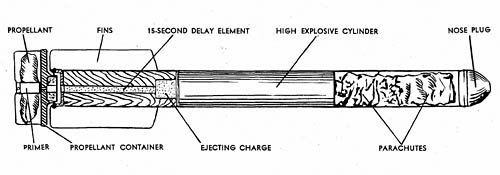
This antiaircraft projectile, fired from the 81 mm barrage mortar, is composed of three sections. The rear portion consists of a primer, black powder charge, propelling charge, 15-second delay train, and a black powder ejecting charge. The explosive cylinder, or middle section, comprises a 40-second delay pellet in a central cylinder and three H.E. pellets cast around the delay element. The forward end section contains a wooden nose plug, two parachutes, and a suspension cord.
The projectile is slid down the mortar tube in a manner similar to the firing of a standard mortar shell. Upon striking the firing pin, the primer is ignited, and it, in turn, sets off the loose black powder in the base of the round. The black powder ignites the propellant and the 15-second delay train. The shell is propelled from the mortar and continues in flight until the delay train ignites the ejecting charge which forces out the wooden nose plug, the two parachutes, the suspension cord, and the explosive cylinder. At the same time, the 40-second delay pellet is ignited. The explosive cylinder is suspended by a small parachute attached to the cylinder by 12-inch strands, and by a larger parachute attached to the cylinder by the 30-foot suspension cord. The end of the suspension cord is covered with match composition and acts as a pull igniter. If an airplane strikes the suspension cord of the floating high explosive assembly, the jerk on the cord pulls the end of the cord through the primer, causing detonation of the high explosive. If the pull igniter is not functioned, the burning train of the 40-second delay pellet reaches the detonator and sets off the explosive cylinder.
An 81 mm flare shell, identical in external appearance except for color markings, is also used. It contains two parachutes and a flare, apparently of a magnesium composition. When the projectile is in flight, a 15-second delay train sets off an ejecting charge of black powder which forces out the nose plug, parachutes, and flare. The burning of the ejecting charge ignites the flare, which floats earthward on the parachutes.
SPECIFICATIONS
| Caliber | 81 mm | |
| Length (overall) | 21 3/8 ins. | |
| Diameter of cylinder | 1 9/16 ins. | |
| Size of fins | 7/8 in. x 4 3/4 ins. | |
| Color | Black with tan nose plug |
Japanese: p. 310.1 (May 1, 1945)